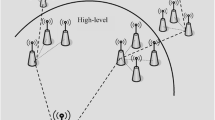Abstract
In this paper, we utilize clustering to achieve energy efficiency for the on–off wireless sensor network, whose member nodes alternate between active and inactive states. In the proposed Distributed and Energy Efficient Self Organization (DEESO) scheme, the head election is adjusted adaptively to the remaining battery levels of local active nodes, which is a completely distributed approach compared to LEACH that relying on other routing schemes to access global information. Furthermore, we apply the Adaptive Channel Assignment (ACA) to address the on-off topology changes. Simulation results show that DEESO delivers 184% amount of data to the base station as LEACH for the same amount of energy consumption and the effective network lifetime is extended by around 50%.
Similar content being viewed by others
References
I. F. Akyildiz W. Su Y. Sankarasubramaniam E. Cayirci (2002) ArticleTitleA survey on sensor networks IEEE Communications Magazine 20 102–114
R. Min M. Bhardwaj S.-H. Cho N. Ickes E. Shih A. Sinha A. Wang A. Chandrakasan (2002) ArticleTitleEnergy-centric enabling technologies for wireless sensor networks IEEE Wireless Communications Magazine 9 28–39
T. Shepard, A channel access scheme for large dense packet radio networks. In Proc. ACM SIGCOMM, Stanford, CA, pp. 219–230, Aug. 1996
M. Ettus, System capacity, latency and power consumption in multihop-routed ss-cdma wireless networks, In Proc. Radio and Wireless Conf. (RAWCON’98), Colorado Springs, CO, pp. 55–58, Aug. 1998
R. Ramanathan M. Steenstrup (1998) ArticleTitleHierarchically-organized, multihop mobile wireless networks for quality-of-service support Mobile Networks & Applications 3 IssueID1 101–119
A. B. McDonald T. F. Znati (1999) ArticleTitleA mobility-based framework for adaptive clustering in wireless ad hoc networks IEEE Journal on Selected Areas in Communications 17 1466–1487
N.H.V. et al. “A cluster-based approach for routing in dynamic networks,” ACM Computing Communication Review, Vol. 17, No. 2, 1997
W. B. Heinzelman A. P. Chandrakasan H. Balakrishnan (2002) ArticleTitleAn application-specific protocol architecture for wireless microsensor networks IEEE Trans. Wireless Commun. 1 IssueID4 660–670
L. Zhao and Q. Liang, “Distributed and energy efficient self-organization for on-off wireless sensor networks,” In 15th IEEE Int. Symp. On Personal, Indoor and Mobile Radio Communications (PIMRC’04), Barcelona, Spain, September 2004
T.-C. Hou T.-J. Tsai (2001) ArticleTitleAn access-based clustering protocol for multihop wireless ad hoc networks IEEE Journal on Selected Areas in Communications 19 1201–1210
T. S. Rappaport (2002) Wireless Communications: Principles and Practice Prentice-Hall Upper Saddle River, NJ
Wireless LAN Medium Access Control (MAC) and Physical Layer (PHY) Specifications, IEEE Std., Rev. 802. 11, 1997
Author information
Authors and Affiliations
Corresponding author
Rights and permissions
About this article
Cite this article
Zhao, L., Liang, Q. Distributed and Energy Efficient Self-Organization for On–Off Wireless Sensor Networks. Int J Wireless Inf Networks 12, 3–9 (2005). https://doi.org/10.1007/s10776-005-5169-y
Issue Date:
DOI: https://doi.org/10.1007/s10776-005-5169-y




